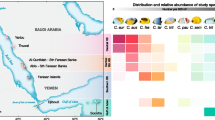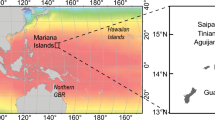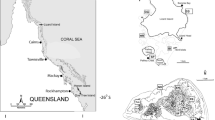Abstract
Many species vary in their ecology across their geographic ranges in response to gradients in environmental conditions. Such variation, which can influence life history traits and subsequent demography of populations, usually occurs over large spatial scales. However, describing and understanding the causes of such variation is difficult precisely because it occurs over such large spatial scales. In this study, we document spatial variation in the ecology of a common reef fish, Stegastes beebei, in the Galápagos Islands and test a number of potential causal mechanisms. The pattern resembles that seen in latitudinal variation: individuals are larger, occur in higher densities, and live longer in the coldest region of the islands than those in the warmest region. However, in this system, demography varies among regional populations separated by <150 km. Preferred nutritious algae are more available in the cold region and comprise a greater proportion of the diet of fish in this region. Per gram reproductive effort appears to be strongly related to temperature, despite differences in the gross magnitude and timing of reproduction in different regions. A model of reproductive output suggests that fish in the warmest region are allocating a greater proportion of available energy to reproduction, resulting in apparent regional life history tradeoffs. Our data suggest that regional demographic differences in S. beebei may be driven by a combination of variation in food availability and an environmentally mediated life history tradeoff.






Similar content being viewed by others
References
Asoh K, Yoshikawa T (2002) The role of temperature and embryo development time in the diel timing of spawning in a coral-reef damselfish with high-frequency spawning synchrony. Environ Biol Fishes 64:379–392
Atkinson D, Sibly RM (1997) Why are organisms usually bigger in colder environments? Making sense of a life history puzzle. Trends Ecol Evol 12:235–239
Banks SA, Wiedenfeld D (2003) Ecological monitoring in the Galapagos Marine Reserve: an integrated approach. Fundación Charles Darwin, Santa Cruz, Galapagos
Belk MC, Houston DD (2002) Bergmann’s rule in ectotherms: A test using freshwater fishes. Am Nat 160:803–808
Blanchette CA, Miner BG, Gaines SD (2002) Geographic variability in form, size and survival of Egregia menziesii around Point Conception, California. Mar Ecol Prog Ser 239:69–82
Boyce MS (1978) Climatic variability and body size variation in muskrats (Ondatra zibethicus) of North America. Oecologia 36:1–19
Brown JH (1995) Macroecology. University of Chicago Press, Chicago
Chatfield C (1992) The analysis of time series: an introduction, 4th edn. Chapman and Hall, London
Choat JH, Axe LM (1996) Growth and longevity in acanthurid fishes: an analysis of otolith increments. Mar Ecol Prog Ser 134:15–26
Choat JH, Robertson DR (2002) Age-based studies. In: Sale PF (ed) Coral reef fishes: dynamics and diversity in a complex ecosystem. Academic, San Diego, pp 57–80
Choat JH, Robertson DR, Ackerman JL, Posada JM (2003) An age-based demographic analysis of the Caribbean stoplight parrotfish Sparisoma viride. Mar Ecol Prog Ser 246:265–277
Conover DO, Present TMC (1990) Countergradient variation in growth-rate: compensation for length of the growing-season among Atlantic silversides from different latitudes. Oecologia 83:316–324
Danilowicz BS (1995) The role of temperature in spawning of the damselfish Dascyllus albisella. Bull Mar Sci 57:624–636
Doherty PJ (1983) Diel, lunar and seasonal rhythms in the reproduction of two tropical damselfishes: Pomacentrus flavicauda and Pomacentrus wardi. Mar Biol 75:215–224
Edgar GJ, Banks S, Farina JM, Calvopina M, Martinez C (2004) Regional biogeography of shallow reef fish and macro-invertebrate communities in the Galapagos archipelago. J Biogeogr 31:1107–1124
Ferreira BP, Russ GR (1992) Age, growth and mortality of the inshore coral trout Plectropomus maculatus (Pisces, Serranidae) from the central Great Barrier Reef, Australia. Aust J Mar Freshw Res 43:1301–1312
Forrester GE (1990) Factors influencing the juvenile demography of a coral reef fish. Ecology 71:1666–1681
Gilligan MR (1991) Bergmann ecogeographic trends among triplefin blennies (Teleostei, Tripterygiidae) in the Gulf of California, Mexico. Environ Biol Fishes 31:301–305
Glynn PW, Wellington GM (1983) Corals and coral reefs of the Galápagos Islands. University of California Press, Berkeley
Graves GR (1991) Bergmann’s rule near the equator: latitudinal clines in body size of an Andean passerine bird. Proc Nat Acad Sci USA 88:2322–2325
Gust N, Choat JH, McCormick MI (2001) Spatial variability in reef fish distribution, abundance, size and biomass: A multi-scale analysis. Mar Ecol Prog Ser 214:237–251
Gust N, Choat JH, Ackerman JL (2002) Demographic plasticity in tropical reef fishes. Mar Biol 140:1039–1051
Hixon MA (1991) Predation as a process structuring coral reef fish communities. In: Sale PF (ed) The ecology of fishes on coral reefs. Academic, San Diego, pp 475–508
Hixon MA, Webster MS (2002) Density dependence in reef fish populations. In: Sale PF (ed) Coral reef fishes: dynamics and diversity in a complex ecosystem. Academic, San Diego, pp 303–325
Holbrook SJ, Schmitt RJ (1988) Effects of predation risk on foraging behavior: mechanisms altering patch choice. J Exp Mar Biol Ecol 121:151–163
Houvenaghel GT (1984) Oceanographic setting of the Galápagos Islands. In: Perry R (ed) Key environments, Galápagos. Pergamon, Oxford, pp 43–54
James FC (1970) Geographic size variation in birds and its relationship to climate. Ecology 51:365–390
Johnston RF, Selander RK (1973) Evolution in house sparrow 3. Variation in size and sexual dimorphism in Europe and North and South America. Am Nat 107:373–390
Jones GP (1986) Food availability affects growth in a coral-reef fish. Oecologia 70:136–139
Jones GP, McCormick MI (2002) Numerical and energetic processes in the ecology of coral reef fishes. In: Sale PF (ed) Coral reef fishes: dynamics and diversity in a complex ecosystem. Academic, San Diego, pp 221–238
Kimura DK (1980) Likelihood methods for the von Bertalanffy growth curve. Fish Bull 77:765–776
Krebs JR, Davies NB (1978) Behavioural ecology: an evolutionary approach. Blackwell Scientific, Oxford
MacArthur RH, Pianka ER (1966) On optimal use of a patchy environment. Am Nat 100:603–609
Meekan MG, Wellington GM, Axe L (1999) El Nino-Southern Oscillation events produce checks in the otoliths of coral reef fishes in the Galápagos Archipelago. Bull Mar Sci 64:383–390
Meekan MG, Ackerman JL, Wellington GM (2001) Demography and age structures of coral reef damselfishes in the tropical eastern Pacific Ocean. Mar Ecol Prog Ser 212:223–232
Nagy KA, Shoemaker VH (1984) Field energetics and food consumption of the Galapagos marine iguana, Amblyrhynchus cristatus. Physiol Zool 57:281–290
Ochi H (1985) Temporal patterns of breeding and larval settlement in a temperate population of the tropical anemonefish, Amphiprion clarkii. Jpn J Ichthyol 32:248–257
Palacios DM (2002) Factors influencing the island-mass effect of the Galapagos Archipelago. Geophys Res Lett 29:2134–2137
Robertson DR (1991) The role of adult biology in the timing of spawning of tropical reef fishes. In: Sale PF (ed) The ecology of fishes on coral reefs. Academic, San Diego, pp 356–386
Robertson DR, Green DG, Victor BC (1988) Temporal coupling of production and recruitment of larvae of a Caribbean reef fish. Ecology 69:370–381
Robertson DR, Petersen CW, Brawn JD (1990) Lunar reproductive cycles of benthic-brooding reef fishes reflections of larval biology or adult biology? Ecol Monogr 60:311–330
Rubenstein DR, Wikelski M (2003) Seasonal changes in food quality: a proximate cue for reproductive timing in marine iguanas. Ecology 84:3013–3023
Sanford E (1999) Regulation of keystone predation by small changes in ocean temperature. Science 283:2095–2097
Stearns SC (1992) The evolution of life histories. Oxford University Press, New York
Steneck RS, Dethier MN (1994) A functional-group approach to the structure of algal-dominated communities. Oikos 69:476–498
Thresher RE (1984) Reproduction in reef fishes. T.F.H. Publications, Neptune City, NJ
Tyler WA, Stanton FG (1995) Potential influence of food abundance on spawning patterns in a damselfish, Abudefduf abdominalis. Bull Mar Sci 57:610–623
Wellington GM, Strong AE, Merlen G (2001) Sea surface temperature variation in the Galapagos Archipelago: A comparison between AVHRR nighttime satellite data and in situ instrumentation (1982–1998). Bull Mar Sci 69:27–42
Werner EE, Hall DJ (1974) Optimal foraging and size selection of prey by bluegill sunfish (Lepomis macrochirus). Ecology 55:1042–1052
Werner EE, Gilliam JF, Hall DJ, Mittelbach GG (1983) An experimental test of the effects of predation risk on habitat use in fish. Ecology 64:1540–1548
Wikelski M, Wrege PH (2000) Niche expansion, body size, and survival in Galapagos marine iguanas. Oecologia 124:107–115
Wootton RJ (1990) Ecology of teleost fishes. Chapman and Hall, London
Zar JH (1999) Biostatistical analysis, 4th edn. Prentice Hall, Upper Saddle River, NJ
Acknowledgements
We thank the staff of the Charles Darwin Research Station, the Galápagos National Park Service, the crew of the Beagle, and Ecoventura and the crew of the Sky Dancer for providing essential logistical support, laboratory space, and field assistance. Mil gracias a A. Astorga and y todos del Equipo Damisela. S. Banks and D. Palacios provided unpublished data. Thanks to P. Munday, W. White, S. Hamilton, J. Standish, C. Osenberg, and an anonymous reviewer for discussions and comments on drafts of this manuscript, and to W. White and B. Kinlan for assistance with programming and statistics. Funding was provided by the UC Regents, the International Society for Reef Studies–The Ocean Conservancy, the David and Lucille Packard Foundation, the Graduate Division of the University of California, Santa Barbara, the American Society of Ichthyologists and Herpetologists, the PADI Project AWARE Foundation, The Explorer’s Club, and Sigma Xi. This paper represents contribution number 185 from the Partnership for Interdisciplinary Study of Coastal Oceans. Procedures used in this study complied with the laws of Ecuador and the United States.
Author information
Authors and Affiliations
Corresponding author
Additional information
Communicated by Craig Osenberg
Rights and permissions
About this article
Cite this article
Ruttenberg, B.I., Haupt, A.J., Chiriboga, A.I. et al. Patterns, causes and consequences of regional variation in the ecology and life history of a reef fish. Oecologia 145, 394–403 (2005). https://doi.org/10.1007/s00442-005-0150-0
Received:
Accepted:
Published:
Issue Date:
DOI: https://doi.org/10.1007/s00442-005-0150-0




